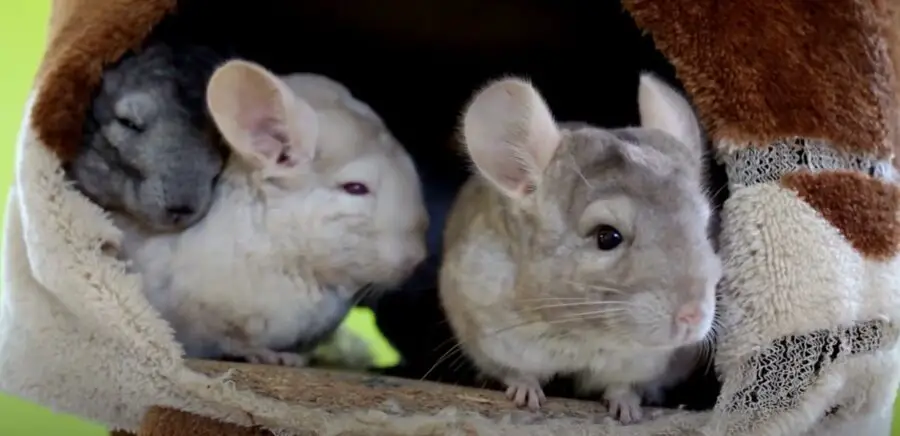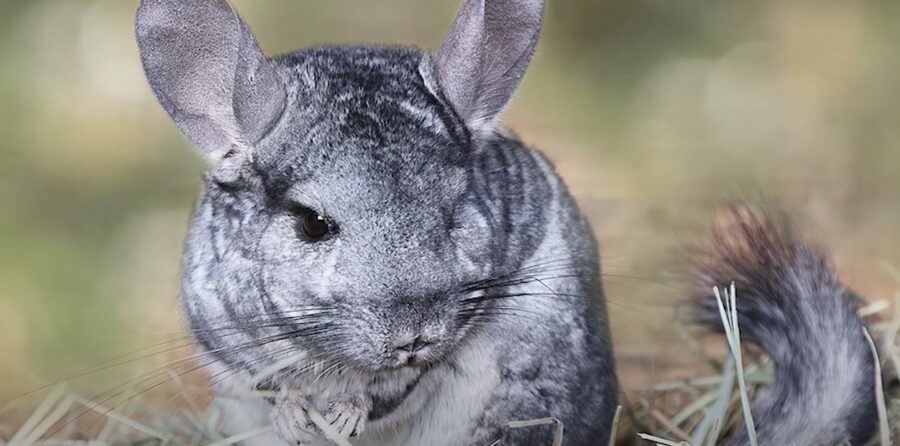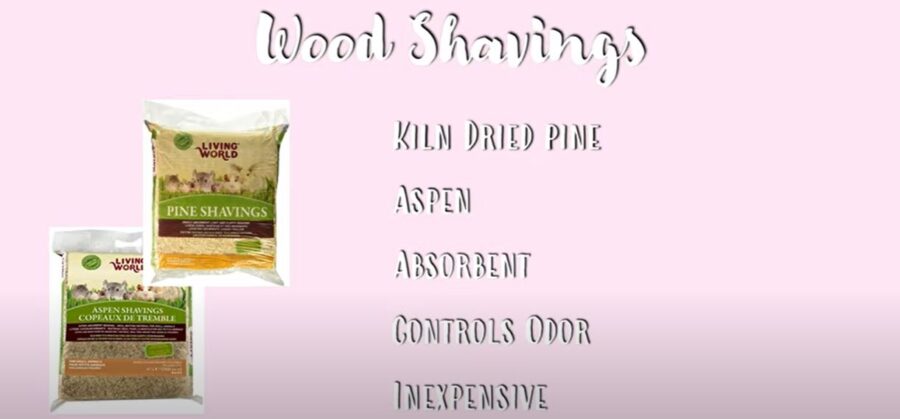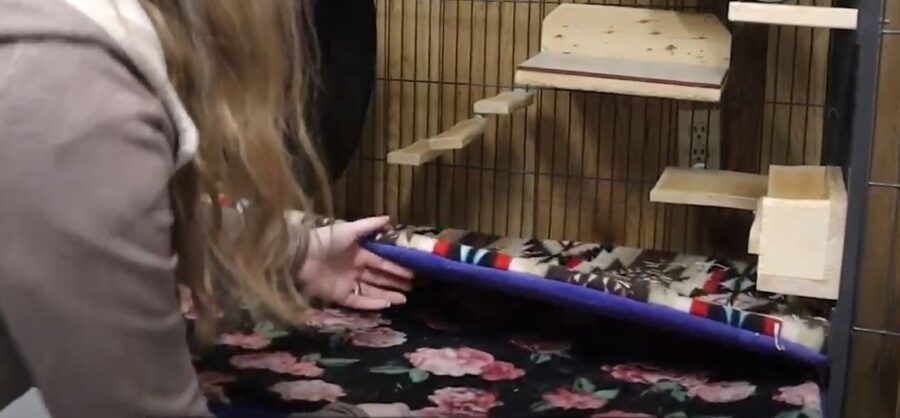I used to wonder what type of bedding can I use for my chinchilla? After hours of research and conversation with members of the chinchilla lovers community, I realized I had some great options.
What is the safest bedding for chinchillas? Is bedding an absolute must for chinchillas? Are you concerned about your chinchilla eating their bedding and getting sick?
In this article, we will run through the choices to discover what type of bedding can I use for my chinchilla and yours too!
What Type of Bedding Can I Use for My Chinchilla?
Your chinchilla can enjoy multiple bedding types from:
- shredded paper
- aspen shavings
- pine shavings (kiln-dried only)
- recycled wood pulp
- hay
- cardboard
- anti-pilled fleece
The most important element to choosing the right bedding is making sure it is dust and ink free. Chinchillas will ingest loose fabric materials, therefore you should choose anti-pill fleece if you are choosing fabric lining.
They can eat up paper and cardboard, making the overall best in our opinion to be aspen shavings or kiln-dried pine shavings.

What Kind of Bedding Is Safe for Chinchillas?
Some of the most popular choices for chinchilla bedding start from shredded paper and work their way through wood shavings, to fleece and ultimately end up with no bedding at all which could mean the use of tile or plexiglass instead.
The safest and most comfortable form of chinchilla bedding in our opinion is kiln-dried pine shavings that are treated and heated in ovens to add to their safety.
Any chemical compounds that can be found in pine shavings are heated off and this makes it the most safe when choosing kiln-dried over any types of wood-based shavings.
What Should I Put at the Bottom of My Chinchillas Cage?
You have the freedom to choose from many options to line your chinchilla’s cage with bedding or hard surfaces. You can choose from
- plexiglass
- tile
- wire floor
- wood shavings
- cardboard
- shredded paper
- aspen shavings
- pine shavings
- commercial brands like Carefresh
- hay
- grass
If you are tired of using bedding and your chinchilla prefers a hard surface, consider tile or plexiglass instead.
A wire floor is great for their droppings to release and fall under the cage onto a tray, but their feet could get stuck in between the mesh wiring.
Choose the option that works best for your chinchilla. Some chinchillas display different behaviors than others. If a chinchilla is eating their bedding made of paper based products, then switch to kiln-dried pine shavings.
Does a Chinchilla Need Bedding?
Chinchillas can remain comfortable in temperatures at 60°F-75°F. This is because their fur coats are dense. With the humidity down to less than 60%, you may opt for not using any bedding.
In colder weather, chinchillas will naturally be cuddling up in tighter spaces together or nesting alone to stay warm.
The bedding you choose should be dust, chemical and ink free. It should also be safe for consumption because they are known to gnaw and ingest parts of their bedding from time to time.

What Materials Are Safe for Chinchillas?
Chinchillas need attention and the materials in their enclosure can promote fun and encourage their curious behavior. This is why we place chew toys and others interactive materials like:
- wild wood
- dried grape vines
- hay
- multi-level playpens
- exercise wheels
We stay away from bamboo, cardboard, newspapers and plastics due to the lack of digestibility that could lead to impaction or other digestive problems.
What Do Chinchillas Like to Sleep On?
The trick to finding out what your chinchilla likes to sleep on is to carefully observe their unique behaviors because no two chinchillas are the same.
Some chinchillas prefer tight spaces in the far corners of their enclosure. They are likely to enjoy a nest box, hammock or warm bedding such as aspen shavings, kiln dried pine shavings or anti-pill fleece.
Chinchillas in the wild are happy to nestle up together their groups to create extra warmth. They like sleeping on surfaces that are soft and comfortable, but one of our chinchillas really enjoys sleeping on a cool piece of tile instead during the warmer seasons.
It is best to provide your chinchilla with options in the enclosure and different spaces to allow them to make the final decision on what type of surface they would like to sleep on.
Are Towels Safe for Chinchillas?
No. We do not recommend using towels, blankets or other types of synthetic fibers in a chinchilla cage without your supervision.
You can use these materials together with your chinchilla but they are unsafe because of the impaction, bloating or toxicity that can result from chinchillas ingesting some of these items.
There are many cases of chinchillas dying due to the ingestion of pieces of towels. When it comes to using any type of fabric or material we recommend anti pilling forms of fleece.

Can You Use Fleece for Chinchilla Bedding?
Yes. Many chinchilla owners who are not interested in constantly changing their favorite animal’s bedding every week choose to wash a yard of fleece instead. You can make it a perfect sized liner for the chinchilla’s cage.
If you are wondering, “Can chinchillas have fleece bedding?” the answer is yes. We recommended to cover the area and tuck it under the edges, to prevent your chinchillas from being able to chew on it.
What Is Anti Pilling Fleece?
If the fleece is anti-pill fleece, the fabric is twisted and packed tightly together. This reduces pilling which makes it easy for rodents such as chinchillas to ingest fibers by pulling them apart.
This is why we suggest that anti-pill fleece is the winner for any type of fabric instead of using conventional bedding like shredded paper.
What Is the Best Chinchilla Bedding?
When it comes to the best chinchilla bedding we recommend the safest possible forms. Since bedding comes in many different shapes, sizes and colors, the choices are endless.
Most importantly there shouldn’t be any chemicals, inks or dust in any of these bedding options. Secondly, using paper-based products could create intestinal blockages.
Our favorite and best form of chinchilla bedding that is disposable would have to be kiln-dried pine shavings. They are heated and treated in large ovens to kill off any types of chemicals and works well for chinchillas or other sensitive pocket pets.
Finally, this type of bedding is inexpensive and easy to replace each week as part of your maintenance and cleaning schedule.
Why Use Kiln-Dried Bedding?
If you choose wood shavings that are untreated, you are not going to be sure that the chemical compounds or dust inside them are deemed safe for your chinchilla.
We’re here to inform you that they are not safe. Your chinchilla has a very sensitive respiratory system and liver.
What you need to do is purchase kiln-dried pine shavings which have been placed in high-temperature ovens to break down the chemicals and remove any dust in the process to make it harmless and safe.
Aspen Shavings for Chinchillas
Aspen shavings are also considered a very safe option for chinchilla bedding. Since aspen is a hard wood, there are no unsafe chemicals contained within compared to pine.
This means that aspen shavings do not need to be placed in a large oven known as a kiln. Aspen shavings are not prone to be dusty. They routinely win in many head-to-head battles for the best bedding for small rodents.
In our opinion, they are slightly more expensive than kiln-dried pine shavings which also ranks at the top of the safe list for chinchilla bedding.
How Often Should I Change My Chinchilla’s Bedding?
Chinchilla bedding should be changed once or twice a week if you are using pine or aspen shavings. You will need to change them more often if they become soiled.
Paper-based bedding needs to be changed three to four times a week if it becomes damp too soon. Fabrics such as anti-pill fleece should be washed every week and placed back in the cage once it is completely dry.
Any other type of fabric is easy to be chewed, pulled and torn which may lead to your chinchilla ingesting it.

Why Use Pelleted Bedding?
Bedding in the form of pellets can also be used for chinchillas. They are heavier than shavings and less prone to becoming damp or clumpy.
Since pelleted bedding is more absorbent, these forms of straw pallets will not expand when wet. It will also not expand in the intestines of a chinchilla if accidentally ingested compared to paper or wood pulp.
You can change these pellets out once every two weeks or once a week depending on how often they become fully soiled.
Can You Use Paper Bedding for Chinchillas?
The most conventional form of bedding for small animals such as chinchillas is paper bedding. Some might say it’s straw or hay, but since paper is so ready to leave available, it’s easy for people to shred and place them in chinchilla enclosures.
It is a cheap and cost-effective, but is paper bedding safe for chinchillas? Why can’t chinchillas have paper bedding? The problem lies with any type of paper bedding with ink inside and even if it is treated, unscented and free of ink, your chinchilla is most likely going to ingest some of it.
Small bits of ingested paper bedding is considered fine, but it adds up. Preventing intestinal blockage is very important for sensitive digestive systems in the small rodents. They may also chew on soiled paper which can create bacterial infections as well.
Do Chinchillas Need Bedding?
Yes. Even if your chinchilla enjoys smooth, hard surfaces such as plexiglass or tile, there should always be some form of bedding nearby.
- Bedding is a good option for preventing urine from pulling up.
- It is absorbent and used as a form of litter as well.
- Bedding also prevent your chinchilla’s feet from being hurt. Chinchilla feet on solid surfaces for too long they can develop a condition known as bumblefoot.
- Bedding also helps to prevent smells and stains.
- It also prevents bacteria from reaching the fur or skin as well.
You can choose from paper, wood or fabric bedding options. We recommend:
- anti-pill fleece
- kiln-dried pine shavings
- aspen shavings
These are better options than paper which is easy to get soiled and digested in large amounts from chinchillas who are bound to chew on them.
Do Chinchillas Like Blankets or Nests?
Chinchillas make nests in the wild when the environment is colder and hospitable. They can withstand temperatures between 60-75 degrees Fahrenheit in comfort. They prefer to make nests to care for their young.
A chinchilla is not going to make a nest from the bedding that you provide in the cage. This is because they are warm and comfortable in their enclosure already.
A blanket is not a good option. This is because they can easily tear away at the fabric and ingest it. Intestinal blockages may develop that could lead to fatal consequences. Keep blankets and towels away from your chinchilla’s cage.

Can You Use Hay Bedding for Chinchillas?
Hay is not a suitable bedding for chinchillas. Frankly, chinchillas eat hay and this makes it very confusing for them. Should they be sleeping on it, soiling it, or eating it?
Hey is an essential part of a chinchilla’s staple diet. If you line a chinchilla’s cage with an abundance of hay, it’s going to be covered in urine and feces eventually.
Your chinchilla is not going to stop eating it however. This creates unsanitary conditions. Hay should be kept in a separate area away from their bedding.
Do Chinchillas Need a Lot of Bedding?
No. You can create a space where chinchillas have bedding and other spaces where there is no bedding, but only smooth hard surfaces.
Chinchillas will enjoy hiding spaces, exercise areas and places where they can feel comfort away from dust or other chemicals.
Are you wondering how many inches of bedding do chinchillas need? When you’re considering chinchillas who enjoy jumping and playing around, shredded paper bedding, pelleted bedding or wood shavings should only be 1 to 2 inches thick. This is enough to absorb liquid and other odors.
How Do You Wash Chinchilla Bedding?
If you are using fleece as a form of chinchilla bedding, we recommend that you choose anti-pilling options.
This means that the fabrics have been woven tighter and packed together to prevent chinchillas from being able to pull on them and ingest unsafe materials that can cause digestive impactions.
Wash the bedding every week. Take everything out of the cage, clear it out and place the fleece liner inside the washing machine. Dry or hang it and make sure that there is no more moisture left inside before placing it back in your chinchilla’s cage.
This is why it’s useful to have two sets of anti-pill fleece liners for your chinchilla’s cage. You can wash one and replace it with your spare while the first one hangs to dry.
Thank you for visiting PocketPetCentral.com for the best information to help you enjoy the life of your pocket pet companion in a fun, safe & healthy way.


